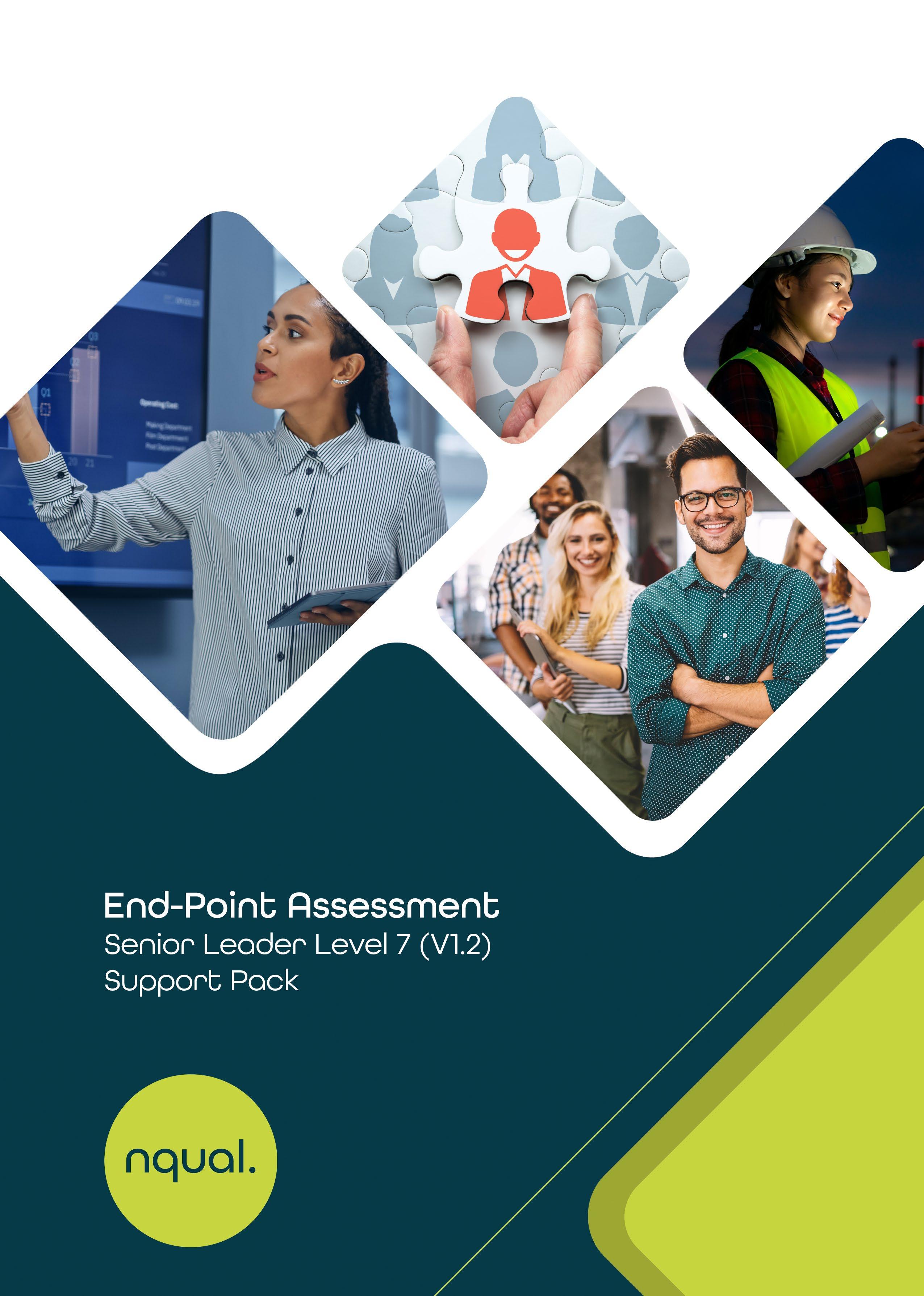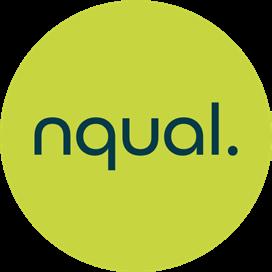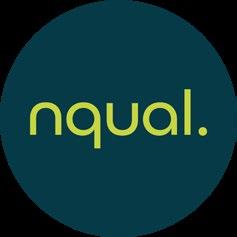E P A T I M E S C A L E
Register with NQual
Training Providers should register apprentices for EPA with NQual a minimum of 90 days before assessment. Providers will pay a registration fee of £30.
This is when the employer, apprentice and training provider confirm that the apprentice is ready for End-Point Assessment. All evidence should be uploaded to NQual a maximum of 14 weeks prior to EPA.
EPA Booking
The training provider should complete the booking section on the Gateway form or training providers can arrange the booking via ACE360 NQual will confirm booking within 48 hours.
NQual will send an invoice for the remaining fee once EPA is approved. EPA Approved
The apprentice will complete a Strategic Business Proposal with Questioning and a Professional Discussion. Assessment
Results will be communicated within 10 working days of final assessment. If the apprentice passes, NQual will send details to the apprentice and training provider containing an EPA results document. If the apprentice fails, NQual will send details to the learner and training provider outlining feedback and next stages. Results
Gateway
G A T E W A Y
This section outlines the requirements an apprentice must have met in order to complete their End-Point Assessment.
Once the employer is fully satisfied that the apprentice has the knowledge, skills and behaviours set out within this standard, the employer can formally confirm that the apprentice is ready for EPA via Gateway.
Gateway requirements for Senior Leader Level 7 outline the apprentice must:
• Have a chieved m aths and English level 2
• S ubmit a P ortfolio of E vidence
• S ubmit a proposal scope
The Gateway form must be sent to NQual between 6-14 weeks before End-Point Assessment is carried out, along with the evidence listed above.
You can access the NQual Gateway form by emailing: admin@nqual.co.uk
*For those with an education, health and care plan or a legacy statement, the apprenticeships English and mathematics minimum requirement is Entry Level 3 and British Sign Language qualification are an alternative to English qualifications for whom this is their primary language
P O R T F O L I O O F E V I D E N C E
As part of the apprenticeship, apprentices are required to prepare a Portfolio of Evidence which will be developed on programme to demonstrate their practice in achieving the knowledge, skills, and behaviours (KSBs) associated with the professional discussion.
The on-programme portfolio that will inform the Professional Discussion might include observations (key component of your portfolio), witness statements, Q&A, professional discussions, 360-degree feedback, product evidence, progress reviews, development plans (*please note that this is not an exhaustive list)
The portfolio should not include reflective accounts or any methods of self-assessment. Any employer contributions should focus on direct observation of performance (for example witness statements) rather than opinions
The submission should typically be 18 pieces of evidence.
C
Strategic Business Proposal, Presentation with Questioning
The assessment method is the production of a Strategic Business Proposal and Presentation, followed by Questioning. The Strategic Business Proposal must be undertaken after the apprentice has gone through Gateway.
Component One: Strategic Business Proposal
A Strategic Business Proposal involves the apprentice completing a relevant and defined piece of work that has a real business benefit.
This assessment method includes two components:
• An outcome component - a Strategic Business Proposal based on post-Gateway work
• A presentation with questioning to ensure the apprentice is assessed correctly against the KSBs which assigned to this assessment method.
Once the proposal scope is confirmed and accepted by NQual, apprentices have a maximum of 12 weeks to write and submit the Strategic Business Proposal and Presentation.
The Strategic Business Proposal’s word limit is 4,000 words (+/-10% at the apprentice’s discretion) This will exclude tables, graphs, figures, references, and annexes. It will ensure that the knowledge, skills, and behaviours can be evidenced appropriately.
The Strategic Business Proposal must include evidence of board or senior leader sign-off for implementation, to ensure the assessment of S2, which must be included as an appendix so that this can be discussed during the presentation. This could be either an email, letter, or similar written confirmation. The evidence provided must be valid and attributable to the apprentice and the strategic business proposal must contain a statement from the employer confirming this.
In order to ensure the Strategic Business Proposal is robust and sufficiently covers the knowledge, skills, and behaviours it must include:
• An executive summary
• The scope of the strategic business proposal including key performance indicators.
• Objectives
• The Strategic Business Proposal which may include Gantt charts, risk / issue / mitigation, responsibility assignment matrix (RACI matrix)
• Financial budgeting and resources
• Proposed implementation of the Strategic Business Proposal including communications and stakeholder plans.
• Analysis of options identified in the Strategic Business Proposal
• Recommendations and conclusions
• Evidence of senior leader or board agreement to the implementation of the s trategic business proposal
The Strategic Business Proposal must include, in addition to the word count, an annex showing how the strategic business proposal maps to all of the KSBs that are being assessed in this method. The apprentice should complete their Strategic Business Proposal unaided
Component Two: Presentation with Questioning
The presentation with questioning involves the apprentice presenting to their Independent End-Point Assessor. Apprentices will prepare and deliver a presentation that appropriately covers the knowledge, skills and behaviours assigned to this method of assessment. The purpose of the questioning is to seek clarification of the strategic business proposal or presentation to assess those knowledge, skills, and
behaviours that the apprentice did not have the opportunity to demonstrate with the strategic business proposal, although these should be kept to a minimum. The presentation must be submitted at the same time as the strategic business proposal, within 12 weeks from approval of scope. The Independent End-Point Assessor will have two weeks prior to the presentation to review the strategic business proposal.
The presentation will focus and expand upon the strategic business proposal and will allow the apprentice to cover the following:
• What are the intended outcomes and impact of the strategic business proposal?
• How have they undertaken the strategic planning?
• What was the rationale for the activities?
• Further recommendations for future growth and progress
• How they have negotiated with and influenced stakeholders
This component will take 60 minutes plus 10% if required The presentation will typically last for 20 minutes and the questioning for 40 minutes. The apprentice will be asked a minimum of 6 questions at the end of their presentation with 2 questions from each of the themes in the grading descriptors.
To deliver the presentation, the apprentice may need access to:
• Audio-visual presentation equipment
• Flip chart and writing and drawing materials
• Computer
• Any other requirements as notified to NQual on submission of the strategic business proposal and presentation
Professional Discussion Underpinned by a Portfolio of Evidence
The Professional Discussion is a two-way structured discussion between the apprentice and the Independent End-Point Assessor, this gives an opportunity to make detailed and proactive contributions to confirm competency across the knowledge, skills and behaviours that are required to be covered. It allows a range of examples to be brought forward during the conversation and ensures that excellence can be achieved and acknowledged.
The Professional Discussion will be appropriately structured to draw out the best of the apprentice’s competency and cover the knowledge, skills and behaviours assigned to this assessment method. The Professional Discussion will last for 60 minutes, with a time increase of up to 10% for the apprentice to finish their last answer.
The Professional Discussion will have a minimum of 8 questions.
The Portfolio of Evidence can be used in this assessment method to support responses from the apprentice. The portfolio must be provided at Gateway so that the Independent End-Point Assessor has time to review the contents.
The below highlights criteria that will be covered in each assessment component. Please review these details as it will provide guidance on what will be covered in each assessment component.
Learning Outcomes
Knowledge
K2
What is Required
Organisation structures, business modelling, diversity, global and horizon scanning perspectives, governance and accountability, technological and policy implications
K3 New market strategies, changing customer demands and trend analysis
Strategic Business Proposal, Presentation with Questioning
Professional Discussion Underpinned by a Portfolio of Evidence
K4
Innovation, the impact of disruptive technologies (mechanisms that challenge traditional business methods and practices) drivers of change and new ways of working across infrastructure, processes, people and culture and sustainability
K5
K6
K7
Systems thinking, knowledge/data management, research methodologies and programme management.
Ethics and Value-based leadership theories and principles
Competitive strategies and entrepreneurialism, approaches to effective decision making, and the use of big data and insight to Implement and manage change
K8
K9
Financial strategies for example scenarios, modelling and identifying trends, application of economic theory to decisionmaking, and how to evaluate financial and non-financial information such as the implications of sustainable approaches
Financial governance and legal requirements, and procurement strategies
Organisational/team dynamics and how to build engagement and develop high performance, agile and collaborative cultures
K11
K12
K13
Approaches to strategic workforce planning, for example talent management, learning organisations, group work, workforce design, succession planning, diversity, and inclusion.
Influencing and negotiating strategies both upwards and outwards
The external social and political environment and use of diplomacy with diverse groups of internal and external stakeholders
K14 Working with board and other company leadership structures
K15 Brand and reputation management
K16
Working with corporate leadership structures, for example the markets it operates in, roles and responsibilities who its stakeholders are and what they require from the organisation and the sustainability agenda
S4.1
S4.2
S5
Lead change in their area of responsibility, create an environment for innovation and creativity.
Establish the value of ideas and change initiatives and driving continuous improvement
Lead and respond in a crisis situation using risk management techniques
S6
S7
Act as a sponsor/ Ambassador, championing projects and transformation of services across organisational boundaries such as those impacted by sustainability and the UK Net Carbon Zero by 2050 target
Challenge strategies and operations in terms of ethics, responsibility, sustainability, resource allocation and business continuity/ risk management
S8 Apply principles relating to Corporate Social Responsibility, governance, and Regulatory compliance
S9
S10
Drive a culture of resilience and support development of new enterprise and opportunities
Oversee development and monitoring of financial strategies and setting of organisational budgets based on key performance indicators and challenge financial assumptions underpinning strategies
S11 Uses financial data to allocate resources
S12
S13
S14
S15
Oversee procurement, supply chain management and contracts such as consideration of sustainable approaches
Use personal presence and “storytelling” to articulate and translate vision into operational strategies, demonstrating clarity in thinking such as consideration of sustainable approaches.
Create an inclusive culture, encouraging diversity and difference and promoting well-being
Give and receive feedback at all levels, building confidence and developing trust,
and enable people to take risks and challenge where appropriate.
S16
S17
S18
S19
Enable an open culture and highperformance working environment and set goals and accountabilities for teams and individuals in their area
Lead and influence people, building constructive working relationships across teams, using matrix management where required
Optimise skills of the workforce, balancing people and technical skills and encouraging continual development
Manage relationships across multiple and diverse stakeholders
S20
S21
Behaviours
Lead within their area of control/authority, influencing both upwards and outwards, negotiating and using advocacy skills to build reputation and effective collaboration
Shape and manage the communications strategy for their area of responsibility
G R A D I N G & C R I T E R I A
Assessments will result in the apprentice achieving a Fail, Pass, or Distinction. This decision is dependent on whether they have met the standard and its End-Point Assessment criteria.
In order to pass the overall End-Point Assessment, an apprentice must achieve a minimum of a Pass in both components to achieve a Pass overall. To achieve a Distinction, the apprentice must achieve all Pass and all Distinction criteria.
Grading results will be communicated to the apprentice within 10 working days of completion of the final component.
Assessment Breakdown
The final grade will be decided on the following combinations.
Assessment Methods 1: Strategic Business Proposal, Presentation with Questioning
Assessment Methods 2: Professional Discussion Underpinned by a Portfolio of Evidence
The Pass and Distinction descriptors can be found in the tables below separated into Strategic Business Proposal, Presentation and Q&A and Professional Discussion Underpinned by Portfolio of Evidence.
Grading Descriptors for Strategic Business Proposal, Presentation and Q&A
Creates a high-performance strategy, focussing on improving efficiency, changing customer demands and trend analysis and which has support from a range of stakeholders. (K3, S2)
Research K3 K14
Evaluates how the strategic business proposal takes full account of the leadership structures within the organisation and of key stakeholders and manages relationships across stakeholders. (K14, K16, S19)
Critically evaluates the need for improving brand management and reputation, and explains how this would reduce risks to the organisation’s brand
Pass
Creation of a new strategy which improves efficiency for the organisation. Evidence of analysing trends and taking account of customer demand. There must be evidence of support from stakeholders to implement the strategy and successful stakeholder management. An evaluation of how the implementation of the strategy takes account of the leadership structure at the organisation, stakeholder needs, sustainability agenda and other market considerations.
Distinction
A critical evaluation with opinions on the need for improving brand management and reputation. An explanation of how doing so would reduce risks to the brand.
Methodologies and Analysis
K5 K8 K9
S3 S11
B3
Justifies how they selected and used an approach that is underpinned by research using a range of methodologies, critically analysing and synthesising the outcomes and producing creative solutions to areas of ambiguity or complexity. (K5, S3, B3)
Applies economic theories and financial modelling to develop strategies and allocate resources in line with legal, governance and procurement requirements (K8, K9, S11)
Critically evaluates the financial strategies used and justifies recommendations made Pass
The approach taken shows knowledge of methodologies and data management and a justification of how they were used to review complex information, which could be analysed to produce solutions to complex or ambiguous parts of the proposal.
Application of economic theories (such as supply and demand, managing financial risk, economic trends, relationships between value and price) and financial strategies (such as such as trend analysis, forecasting, ROI) to develop the proposal and allocate resources in line with legal, governance and procurement requirements. Knowledge of how to evaluate financial and non-financial information is shown.
Distinction
A critical evaluation of the financial strategies that were used is given and the recommendations that were made as a result of this are justified. Justifications could be based on business continuity, sustainability, governance, analysis of risk, for example.
A minimum of 2 theories/ strategies are required for an evaluation.
Communication
K12 K15
S13 S20
Justifies how they use influencing and negotiating strategies to collaborate with stakeholders and build their organisation’s brand and reputation in developing the strategic business proposal (K12, K15, S20)
Delivers a strategic business proposal and presentation that demonstrates a clear vision for the organisation and translates this into operational strategies (S13)
Persuasive and engaging in articulating strategies that maximise opportunities for sustainable growth based on synthesising complex information including changing customer demand and robust research, critically analysing and justifying proposed solutions and their alternatives
Pass
At least one influencing and one negotiation strategy have been used to collaborate with stakeholders and build the brand and reputation as part of the proposal. The use of strategies is justified. The strategies could include McKinsey, Persuasion Tools model, INSEAD negotiation dynamics model, EI theory, stakeholder management and effective collaboration, for example.
Evidence that the proposal shows a vision for the organisation, which is translated into strategic actions.
Distinction
Evidence that there has been effective communication of the strategy, with an ability to synthesise complex information to the audience. A critical analysis of proposed solutions and alternatives that were considered, justifying the approach taken.
Grading Descriptors for Professional Discussion Underpinned by Portfolio of Evidence
Interprets ethics and value-based leadership theories and principles in order to challenge strategies, operations and financial assumptions and defines their responsibility for resource allocation and overseeing development and monitoring of financial strategies based on KPIs that maintain sustainability and business continuity/risk management (K6, S7, S10)
Summarises how the communications strategy links to their area of responsibility and justifies the approaches taken to shape and manage it, taking account of the external social and political environment and the diverse needs of internal and external stakeholders (K13, K20, S21)
K2 K6 K13 K19 K20
S1 S7 S8 S10 S21
Implements a high-performance strategy, focussing on growth and improving efficiency, synthesising outcomes from modelling and horizon scanning (K2, S1)
Applies the approaches and principles to developing a corporate social responsibility programme and justifies how they apply these principles to ensure the organisation’s compliance to governance and regulations (K19, S8)
Evaluates the effectiveness of the communications strategy for their area of responsibility, explaining how they have acted on analysis and feedback to make recommendations for continuous improvement to the organisation’s overall strategy. Pass
Knowledge is shown of ethics and the principles of values-based leadership, along with at least one values-based leadership theory (this could include theory from Covey and Kraemer). Application of this style of leadership to challenge strategies, operations, and financial assumptions. Detail of accountability for resource allocation and development and monitoring of financial strategies (financial theory is not required in this component). How you use KPIs to monitor this, ensuring sustainability and continuity.
Awareness of the external social and political environment and how this links to the needs of internal and external stakeholders. The communications strategy should be summarised, describing how it has been shaped and adapted to consider stakeholder needs.
Evidence of having implemented a strategy which takes account of the organisation's needs and structure. The strategy should be based on the outcomes of modelling and horizon scanning (such as forecasting, trend analysis, the Three Horizon model, sustainability, talent management) and should plan for growth and improved efficiency.
Analyses their approach to workforce planning, evaluating its effectiveness in developing a diverse, inclusive, resilient and valued workforce that optimises their skills to the benefit of the organisation (K11, S9, S14, B4)
Justifies their approach to overseeing procurement, supply chain management and contracts (S12)
Knowledge of approaches to CSR (such as Carroll’s model) and how this is used to develop a CSR programme for your organisation, which is compliant with governance and regulations.
Distinction
An evaluation of the communications strategy in your area of responsibility is given. The evaluation must show how you have acted on analysis and used feedback (example required) to make suggestions for continuous improvement.
Portfolio evidence could include but is not limited to written accounts to show an understanding of how to apply/ how you have applied a values-based leadership theory, witness testimony or work product showing skills application. The outcomes of research into external factors and stakeholder mapping. Summaries of research into horizon scanning and work product to show what this informed. Summaries of research into CSR principles and how these were applied to developing an internal CSR strategy.
Pass
Analysis of the approach to workforce planning (such as talent management, succession planning, D&I), with an evaluation of how effective it has been in developing a diverse, inclusive resilient and valued workforce that is benefiting the organisation.
Examples of how you oversee procurement, supply chain management and contracts (such
Evaluates how they shape their organisation's mission, culture and values by championing projects as an ambassador that transform services across the organisation (K1, S6)
Justifies how they have worked collaboratively in driving change and implementing new ways of working to improve the sustainability of the organisation and how they have established a creative and innovative environment (K4, S4.1, B1)
Critically analyses approaches to decision making and the use of big data when developing competitive strategies to implement and manage change (K7)
Justifies the risk management techniques they have used to lead and respond to a crisis situation (K17, S5
Drives transformative change with tangible benefits for the organisation
Analyses and evaluates a crisis situation that they have managed explaining and justifying changes to policy and procedure that they recommended as a result of the experience
as consideration of sustainable approaches), with justification of the approach taken.
Portfolio evidence could include but is not limited to work product or written statement to show your approach to workforce planning, witness testimony to show the impact and benefit of approaches taken. Work product or written statement to show evidence of overseeing procurement.
Pass
An evaluation of how you have helped to shape the mission, culture, and values. Examples of how they have acted as an ambassador, championing projects and changes to services to make improvements (for example, to sustainability and UK Net Carbon Zero).
Justification of how you have collaborated to drive change and challenge traditional methods by implementing new ways of working. Examples of how you lead this in your area and promote creativity and innovation.
A critical evaluation of the approach taken to decision-making (A minimum of 2 approaches to decision-making, such as the use of PESTLE, McKinsey, process mapping and brainstorming) and the use of big data (analytical approaches to its use could include SAP, ERP) in developing change strategies.
Justification of risk-management techniques (such as identification, measurement, mitigation, reporting, monitoring, governance) used in a
crisis situation (valid example of leading and managing a crisis situation must be given).
Distinction
Clear evidence of driving transformative change that has had tangible organisational benefits (examples of the benefits are given).
The management of the crisis situation is analysed with an evaluation. Examples are given of changes that were made to policy and procedure, based on learnings from this crisis.
Portfolio evidence could include but is not limited to written accounts showing the application of theory. Work product to evidence how KSBs have been practically applied, such as a summary of big data and what it informed. Witness testimony to show collaboration and leadership in a crisis situation.
Team Working and Development
K10 K18
S4.2 S15 S16 S17 S18
B2 B5
Justifies how they use and encourage continued professional development opportunities for themself and others, as well as coaching and mentoring techniques, to build engagement in their team and develop an agile and collaborative culture of high performance (K10, K18, S18, B5)
Evaluates how they have led and influenced people, building constructive and trustful teams confident to take risks when appropriate and able to respond to and provide constructive feedback and challenge (S15, S17)
Justifies how they have taken responsibility for driving continuous improvement through establishing an open and high-performing working environment with clear goals and accountabilities (S4.2, S16, B2)
Evaluates where they have used coaching and mentoring techniques to improve the performance of an individual or a team with a positive impact for the organisation
Pass
Knowledge of team and organisational dynamics and how to build a team that is agile, collaborative and high-performing. Knowledge of any relevant and recognised coaching and mentoring techniques and other professional development opportunities. A justification of your approach, with examples, is given.
An evaluation of how you lead and influence people and build trusting and constructive relationships. This should include the use of giving and taking on feedback to help build trust and confidence to take risks and to challenge where appropriate.
A justification of how you have set goals and accountabilities to encourage highperformance working, to drive continuous improvement.
Distinction
An evaluation of the use of coaching and mentoring techniques is given, with conclusions on how these techniques have had a positive impact on the individual and/ or the organisation.
Portfolio evidence could include but is not limited to work product showing development opportunities taken/ used, witness testimonies to show outcomes of developing the team. Written statements to evaluate the use of development techniques.
Re-sit / Re-take
If an apprentice Fails one or more component, they will be offered the opportunity to re-sit / re-take the component(s). It is then up to the apprentice’s employer how many attempts an apprentice is given.
The timescale for a re-sit typically takes 3 months and a re-take 6 months (dependent on how much re-training is required). All assessment methods must be taken within a 6-month period, otherwise the entire EPA will need to be resat / retaken.
Where any assessment method must be re-sat or re-taken, the apprentice will be awarded a maximum EPA grade of Pass. Re-sits and re-takes are not offered to an apprentice wishing to move from Pass to a higher grade.
M O C K P R O F E S S I O N A L D I S C U S S I O N
It is the responsibility of the employer and training provider to complete Mock Professional Discussions with the apprentice and the responsibility of the apprentice to ensure they have practis ed answering questions for their EndPoint Assessment.
Professional Discussion materials will be given to the training providers when registering learners with NQual. A Mock Professional Discussion should take 60 minutes (+10%)























